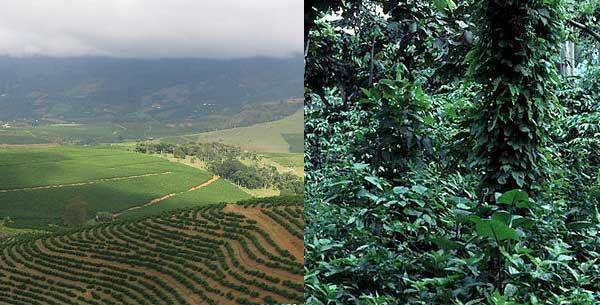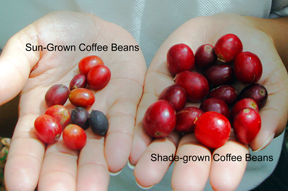The importance of drinking coffee (Part 1)
- Science-by-Trianon

- Jul 5, 2020
- 5 min read
Updated: Apr 10, 2021
Can drinking coffee be sustainable?

I love coffee. And I am not the only one.
Hot or ice-cold, black or with milk, short or long, Irish, Turkish, American, Viennese… It is on the top 10 of the most consumed beverages around the world.[1]
To wake up, to have a boost or just to engage with someone else, 2.25 billion cups of coffee are drunk every day in the world.[2]
Have you ever wondered what this means for the sustainable development of the planet?
The environmental impact of growing coffee

The countries that import the most coffee are in Europe and North America.
The countries that produce it, on the other hand, are generally found in Southern latitudes.
They are two main ways of growing coffee: sun-grown coffee and shade grown coffee and depending on the way coffee is grown, the impact on the environment can be beneficial or detrimental.

Originally, coffee has been grown in the shade of other trees. The problem with that is that it takes longer because the coffee plants receive less sunlight.
Give the massive demand for coffee people found and industrialized ways to grow coffee in direct sunlight. This shortened the time required for the coffee to ripen and increased the yields, but it also led to a decrease in quality.
In short, the problems sun-grown coffee comes with is the standard litany of problems of any monoculture: reduced biodiversity, intensive use of pesticides, deforestation, soil degradation, etc.
And it does not taste as good as the shade grown coffee.
Shade-grown coffee, on the other hand, is very beneficial to the environment.
- It favors high biodiversity,
- reduces or even obliviates the need for pesticides (as some birds species will take care of pest control),
- the trees that provide the shade have the potential to capture more carbon dioxide from the atmosphere (17.2 Gt CO2eq per year) than a country like the USA emits (6.5 Gt),[3]
- it allows the establishment of healthy and resilient ecosystems,
- and enhances decent livelihood for the farmers (health, economics).
It is time to promote a global economy of small farms that prioritise respect of our environment for us, and provide decent ways of living to farmers,
rather than going on supporting the economy of enormous industrial corporations, who export the economic and environmental damage to these countries and whose focus on profits never outweighs the damages they know they are inducing.
The environmental impact of making a cup of coffee
Making a cup of coffee always starts by using electricity or gas to heat the water to brew the coffee.
In addition, many coffee making appliances have a secondary energy cost to power the warming plate to keep the drink hot after you complete the brewing process.
If we compare, the energy needed to boil 500mL with a microwave, an electric tea kettle, an electric stovetop, and an induction stove, the efficiency [4] of these appliances is ranked as follows:
1. Induction stove (85% efficient)
2. Electric tea-kettle (80% efficient)
3. Electric stovetop (70% efficient)
4. Microwave (50% efficient) [5].
When it comes to the coffee machines:

The French press uses the least energy as you only have to heat the water up once.
The drip coffee machine uses the same amount of energy than a kettle but it uses it for a lot more time, and you need extra energy to keep the coffee warm. Moreover, they require the use of disposable filters.
Percolators don’t require such filters but are energetically less favorable because they have to keep the water boiling for a while.
Espresso Machines may use more energy per volume because they heat the water to temperatures higher than 100°C, which needs to be pressurized. They also do not have any waste products (apart from the coffee itself).
For some 20 years now single-serve coffee makers have hit the market, and if you love espresso as I do, you’ll certainly have one at home.
Their increased popularity is a cause for concern because of the amount of disposable capsules they generate. On the upside, they do not generate filter paper waste.

These energetic requirements outlined above, of course, only hold for as long as only the amount of water required for the cup is heated.
Nevertheless, if you are an espresso drinker, they are the only way to have a diversely flavored, well balanced, at a decent price in the comfort of your home.
So how can we combine our love for espresso and our desire to be mindful of the environment?
The environmental impact of drinking coffee

The way you drink coffee makes a difference in your CO2 emissions:

CO2 emission of different types of coffee [6] considering that the exact amount of water needed is boiled. If you boil more than you need, 20 g of CO2eq. can be added
So a black espresso is the greenest option.
Making your espresso with a drip coffee machine or a percolator seems to not be a good idea.
As a matter of fact, studies have shown that to make a cup of black coffee 7 g of beans are needed with these appliances, while only 5.7 g is needed for capsule coffee. Knowing that billions of cups are drunk every day, that means more culture needed, and intensification of industrialised sun-grown coffee.
This brings us back to using Barista or capsules-based machines.
Your first instinct might be to prefer Barista espresso machines, as they do not generate waste, but
Barista machines need more energy than a capsules-based machine to make a single espresso.
Thus, it looks like, if you are an espresso lover, a capsules-based machine is in fact the most sustainable way of drinking coffee.[7]
Which brings us to the problem of the capsules.
They generally come in three varieties: aluminium, plastic, and compostable.

From left to right: aluminium, plastic and compostable coffee capsules
Their common problem is their collection, disposal, and recycling.
Aluminium capsules are fully recyclable (at significant energetic cost!). Their eco-balance depends very much on the degree of circularity.
Plastic capsules need less energy to be produced but as with all cases of plastic packaging, a lot of effort has to be made to ensure that the plastic remains in the cycle and does not get lost to landfills.
Compostable capsules seem to be the solution then, but they are rarely disposed of correctly [8].
If they were all put in the compostable bin collection, they could be sent to bio-refineries but today they end up at the municipal waste disposal plant, are incinerated, and produce methane that is ending up in the atmosphere adding to the greenhouse effect.
So can drinking coffee be sustainable?
The answer is yes. And this is how:
1. Buy a shade grown coffee
2. If you use a drip filter machine, make sure it is energy efficient, do not leave it on, do not boil more water or coffee than you need.
3. Black coffee is better than any milky one. So try to reduce the quantity of milk you use, is milk is a must for you.
4. If you are an espresso drinker, prefer a capsules-based machine
5. Collect your used capsules and bring them to the right recycle point.
This article will be followed by part 2: What to do with coffee waste?
[1] https://www.tasteatlas.com/most-popular-beverages-in-the-world [Last accessed on July 5th, 2020] [2] https://en.wikipedia.org/wiki/Economics_of_coffee [Last accessed on July 5th, 2020] [3] https://www.youtube.com/watch?v=Dp8ol4RRRiA [Last accessed on July 5th, 2020] [4] The efficiency is the amount of energy that is delivered to the water as heat divided by the amount of water the appliance draws in as electricity. [5] http://insideenergy.org/2016/02/23/boiling-water-ieq/ [Last accessed on July 5th, 2020] [6] https://www.theguardian.com/environment/green-living-blog/2010/jun/17/carbon-footprint-of-tea-coffee [Last accessed on July 5th, 2020] [7] https://www.wired.co.uk/article/coffee-pods-n-recycling [Last accessed on July 5th, 2020] [8] https://pedia.co.uk/blogs/coffee-blog/the-environmental-case-for-plastic-coffee-pods [Last accessed on July 5th, 2020]




Comments